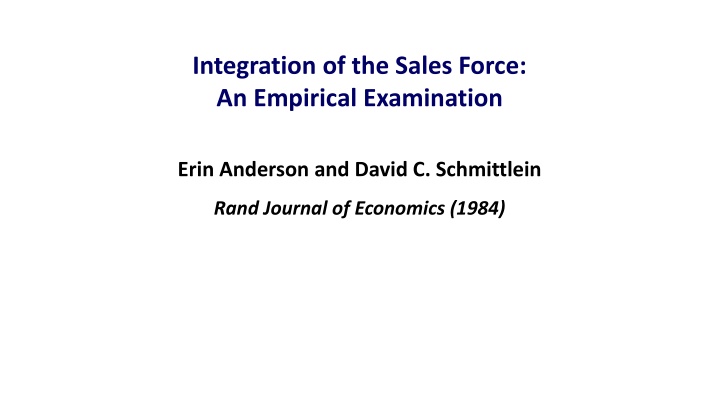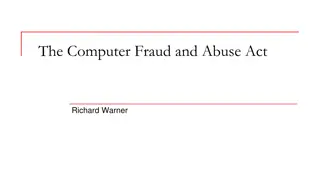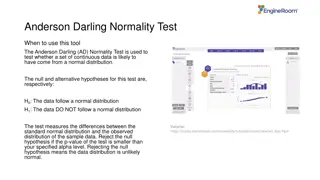
Vertical Integration of Sales Force: A 1984 Empirical Study
Explore the 1984 empirical study by Erin Anderson and David C. Schmittlein on the integration of sales force, focusing on vertical integration and governance mechanisms like market and hierarchical approaches. The study highlights the shift in sales operations from manufacturers' representatives to in-house sales teams, emphasizing human assets over physical assets, with a historical context from 1974 to 1977. The research investigates Asset Specificity, Uncertainty, and Frequency hypotheses based on Transaction Cost Economics (TCE), analyzing factors like knowledge acquisition, environmental unpredictability, and setup costs.
Download Presentation

Please find below an Image/Link to download the presentation.
The content on the website is provided AS IS for your information and personal use only. It may not be sold, licensed, or shared on other websites without obtaining consent from the author. If you encounter any issues during the download, it is possible that the publisher has removed the file from their server.
You are allowed to download the files provided on this website for personal or commercial use, subject to the condition that they are used lawfully. All files are the property of their respective owners.
The content on the website is provided AS IS for your information and personal use only. It may not be sold, licensed, or shared on other websites without obtaining consent from the author.
E N D
Presentation Transcript
Integration of the Sales Force: An Empirical Examination Erin Anderson and David C. Schmittlein Rand Journal of Economics (1984)
Research Question/Problem Formulation OVERARCHING QUESTION: When does vertical integration occur? SPECIFIC QUESTION: Vertical integration of sales force Whether to use an independent manufacturers' representative (market governance) or an in-house" (employee) salesperson (hierarchical governance) to sell a product line EMPIRICAL NOVELTY: Unlike prior literature this research article focuses on human assets rather than physical assets HISTORICAL CONTEXT: 1974: 50% of sales operations in all industries used the market (manufacturers reps) 1977: However, only 10% of U.S. dollar volume in 15 industry categories used the market via reps.
TCE-Based Hypotheses ASSET SPECIFICITY: The knowledge and relationships our salesperson eventually acquires concerning firm A are assets specific to firm A, which results in bilateral exchange relationships.3 The greater the total value of company-specific assets (on the company and customer sides), the greater the likelihood of vertical integration in the form of an in-house sales force. Measurement of Transaction Specificity of Assets (TSA): (i) nature of the company and difficulty in learning the in and outs of the firm; (ii) nature of the product and the amount of needed extra training in this firm by a new salesperson; (iii) confidential information held by the salesperson; (iv) nature of the customer taking time to develop; (v) importance of key accounts that are given special attention; and (vi) customer loyalty based on personal relationships with the salsesperson.
TCE-Based Hypotheses UNCERTAINTY: Environmental unpredictability: contract renegotiation costs The likelihood of integration is expected to increase, given non-trivial asset specificity, with increasing environmental uncertainty. Measurement: Expected deviation between forecast and actual sales in the next year Difficulty of evaluating performance: 1) The infeasibility to record each salesperson s results accurately. 2) Responsibility for a sale may not be assignable to an individual (non-separability) 3) Performance" may not be a simple, readily measurable scalar. The likelihood of integration is expected to increase with the difficulty of evaluating performance. Measurement: semantic differential in response to "It is very difficult to measure equitably the results of individual salespeople." (UDEP)
TCE-Based Hypotheses FREQUENCY: A specialized governance mechanism involves significant setup and maintenance costs Firm must at least break even on the fixed cost of the integration function The likelihood of vertical integration is expected to increase as territorial density (TD) increases Measurement: Negative of the percentage of salespersons' time spent driving or flying, i.e., the less time spent traveling, the denser the territory FIRM SIZE: Economies of scale, economies of scope, market power, the ability to aggregate inputs The greater the firm size, the greater the likelihood of vertical integration in the form of an in-house sales force. Measurement: 1980 company assets in dollars (SIZE)
Data and Model Survey data from the electronic components industry (16 companies) Unit of analysis: the product line of a given company and territory The survey respondents are territory sales managers Asset specificity, environmental uncertainty, difficulty in evaluating performance, territory density, company size (assets in $) are hypothesized to have a positive effect on the likelihood of using a corporate sales personnel(i.e., vertical integration). Interaction terms: asset specificity/environmental uncertainty (ZUESTA) and asset specificity/difficulty in evaluating performance (ZUDEPSTA) The logistic response function (logit model) (Domencich & McFadden, 1975). The coefficients were estimated by maximizing the likelihood function (the Gauss-Newton non-linear least squares method)
RESULTS Empirical Results: ALL EFFECTS Asset Specificity (TSA), Difficulty of Evaluating Performance (UDEP) , and Company Size (SIZE) have the hypothesized (positive) effect on the probability of using an in-house corporate sales force and are statistically significant. Contrary to predictions of transaction costs theory, the expected specificity and uncertainty interactions were not corroborated empirically.






















